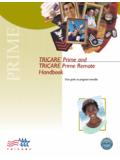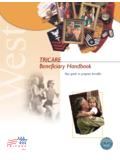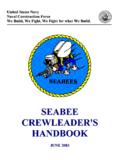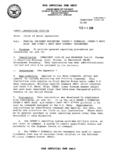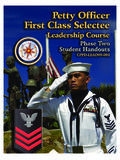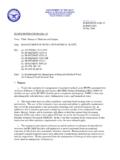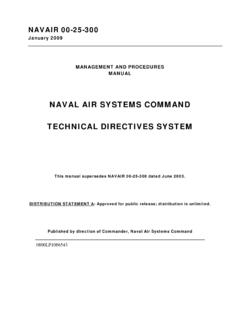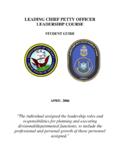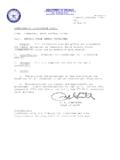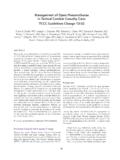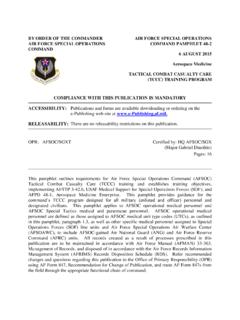Transcription of JP 4-02, Health Service Support
1 26 July 2012 Health Service SupportJoint Publication 4-02 Intentionally Blank i PREFACE 1. Scope This publication provides doctrine for the planning, preparation, and execution of Health Service Support across the range of military operations . 2. Purpose This publication has been prepared under the direction of the Chairman of the Joint Chiefs of Staff. It sets forth joint doctrine to govern the activities and performance of the Armed Forces of the United States in joint operations and provides the doctrinal basis for US military coordination with other US Government agencies during operations and for US military involvement in multinational operations .
2 It provides military guidance for the exercise of authority by combatant commanders and other joint force commanders (JFCs) and prescribes joint doctrine for education and training. It provides military guidance for use by the Armed Forces in preparing their appropriate plans. It is not the intent of this publication to restrict the authority of the JFC from organizing the force and executing the mission in a manner the JFC deems most appropriate to ensure unity of effort in the accomplishment of the overall objective. 3. Application a. Joint doctrine established in this publication applies to the Joint Staff, commanders of combatant commands, subunified commands, joint task forces, subordinate components of these commands, the services , and combat Support agencies.
3 B. The guidance in this publication is authoritative; as such, this doctrine will be followed except when, in the judgment of the commander, exceptional circumstances dictate otherwise. If conflicts arise between the contents of this publication and the contents of Service publications, this publication will take precedence unless the Chairman of the Joint Chiefs of Staff, normally in coordination with the other members of the Joint Chiefs of Staff, has provided more current and specific guidance. Commanders of forces operating as part of a multinational (alliance or coalition) military Preface ii JP 4-02 command should follow multinational doctrine and procedures ratified by the United States.
4 For doctrine and procedures not ratified by the United States, commanders should evaluate and follow the multinational command s doctrine and procedures, where applicable and consistent with US law, regulations, and doctrine. For the Chairman of the Joint Chiefs of Staff: WILLIAM E. GORTNEY VADM, USN Director, Joint Staff iii SUMMARY OF CHANGES REVISION OF JOINT PUBLICATION 4-02 DATED 31 OCTOBER 2006 Adds chapter on force Health protection with subordinate core functional capabilities.
5 Includes time sensitive en route care as part of overarching joint medical capability for Health Service Support . Clarifies United States Transportation Command (USTRANSCOM) policy for patient movement of contaminated, contagious, or potentially exposed casualties. Acknowledges the United States Air Force Air Mobility Command role as the Department of Defense lead agent for aeromedical evacuation policy, training, and standardization of procedures. Assigns theater patient movement requirements center processes and responsibilities to USTRANSCOM Surgeon s Office. Clarifies Special operations Forces Operational Medicine mission and responsibilities.
6 Creates four levels of identification for chemical, biological, radiological, and nuclear hazards; presumptive, field confirmatory, theater validation, and definitive. Eliminates the use of the Joint Medical Analysis Tool as the approved asset for calculating medical requirements. Updates references and acronyms. Summary of Changes iv JP 4-02 Intentionally Blank v TABLE OF CONTENTS PAGE EXECUTIVE SUMMARY .. ix CHAPTER I Health Support TO JOINT operations OVERVIEW Introduction .. I-1 Military Health System .. I-1 Principles of Health Service Support .. I-1 Joint Medical Capabilities .. I-3 CHAPTER II ROLES AND RESPONSIBILITIES Command and Control.
7 II-1 Joint Force Surgeon s Office ..II-1 Organizing the Joint Force Surgeon s Office ..II-9 Joint Force Surgeon s Office Battle Rhythm ..II-23 Staff Organizations ..II-25 Joint Force Surgeon Reachback ..II-32 CHAPTER III Health Service Support Casualty Management .. III-1 Patient Movement .. III-3 Medical Logistics .. III-4 Health Information Management .. III-6 CHAPTER IV FORCE Health PROTECTION Casualty Prevention .. IV-1 Preventive Medicine .. IV-1 Health Surveillance .. IV-2 combat and Operational Stress Control .. IV-2 Preventive Dentistry .. IV-3 Vision Readiness .. IV-3 Laboratory services .. IV-5 Veterinary services .. IV-5 Table of Contents vi JP 4-02 CHAPTER V Health Service Support operations combat operations .
8 V-1 Stability and Civil-Military operations .. V-1 Limited Contingencies and Crisis Response .. V-7 Defense Support of Civil Authorities .. V-7 Special operations Forces .. V-8 Multinational operations .. V-11 Detainee operations .. V-16 operations in a Chemical, Biological, Radiological, and Nuclear Environment .. V-19 Contractor Support .. V-21 CHAPTER VI JOINT Health PLANNING Introduction .. VI-1 Health Support Planning Considerations .. VI-1 Planning Joint Medical Logistics .. VI-11 Systems and Planning Tools .. VI-12 APPENDIX A Hospitalization .. A-1 B Patient Movement ..B-1 C Service Component Transportation Assets.
9 C-1 D Medical Logistics Support .. D-1 E Blood Management .. E-1 F Intelligence Support to Joint Health Support .. F-1 G Casualty Prevention .. G-1 H Patient Area Reception .. H-1 J Medical Aspects of Reintegration .. J-1 K Impacts of the Law of War and Medical Ethics .. K-1 L Planning Checklists .. L-1 M References .. M-1 N Administrative Instructions .. N-1 GLOSSARY Part I Abbreviations and Acronyms .. GL-1 Part II Terms and Definitions .. GL-5 FIGURES II-1 Notional Joint Force Surgeon s Office Organization ..II-11 II-2 Sample Joint Force Surgeon s Office Battle Rhythm.
10 II-24 III-1 Primary Tasks and Purposes of the Medical Logistics Function .. III-5 Table of Contents vii IV-1 Primary Tasks and Purposes of the combat and Operational Stress Control Function .. IV-4 IV-2 Primary Tasks and Purposes of the Laboratory services Function .. IV-5 V-1 Health Service Assessment Factors .. V-6 V-2 Challenges of Patient Movement During Special operations .. V-10 V-3 Health Service Support Challenges in Multinational operations .. V-12 VI-1 Health Support Planning Considerations .. VI-2 VI-2 Patient Movement Item System .. VI-4 B-1 Patient Movement Requirements Center Component Lift Interface ..B-4 B-2 Determining Patient Flow Requirements ..B-7 B-A-1 Notional Aeromedical Evacuation Structure.
